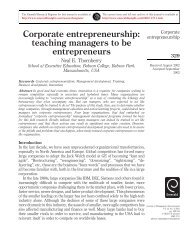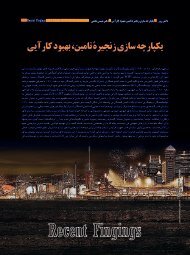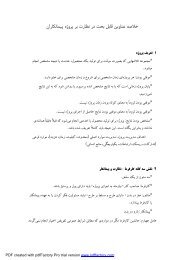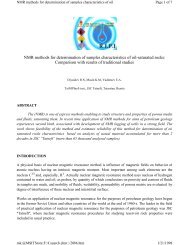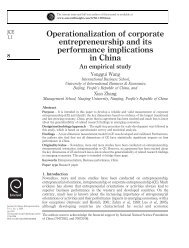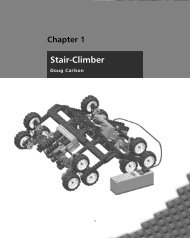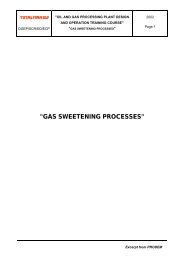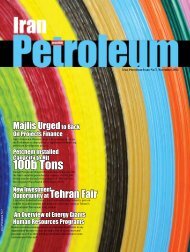The role of capillary pressure curves in reservoir simulation studies ...
The role of capillary pressure curves in reservoir simulation studies ...
The role of capillary pressure curves in reservoir simulation studies ...
You also want an ePaper? Increase the reach of your titles
YUMPU automatically turns print PDFs into web optimized ePapers that Google loves.
<strong>The</strong> <strong>role</strong> <strong>of</strong> <strong>capillary</strong> <strong>pressure</strong> <strong>curves</strong> <strong>in</strong> <strong>reservoir</strong> <strong>simulation</strong> <strong>studies</strong>.<br />
M. salarieh, A. Doroudi, G.A. Sobhi and G.R. Bashiri Research Inistitute <strong>of</strong> pet<strong>role</strong>um Industry.<br />
Key words:<br />
Capillary <strong>pressure</strong> curve, Simulation, hysterises, Water con<strong>in</strong>g, Well production.<br />
ABSTRACT:<br />
Capillary forces are one <strong>of</strong> effective parameters <strong>in</strong> Hydrocarbon Reservoirs which are notable<br />
<strong>in</strong> the porous media. Capillary <strong>pressure</strong> is one <strong>of</strong> <strong>in</strong>put data <strong>in</strong> <strong>reservoir</strong> <strong>simulation</strong> process<br />
which should be considered <strong>in</strong> history match<strong>in</strong>g procedures.<br />
This paper is go<strong>in</strong>g to study the <strong>role</strong> <strong>of</strong> <strong>capillary</strong> <strong>pressure</strong> by us<strong>in</strong>g a black oil s<strong>of</strong>tware named<br />
“IMEX”. <strong>The</strong> data is about a given <strong>reservoir</strong> which is studied for, the curvature and <strong>capillary</strong><br />
<strong>pressure</strong>s Hysterises is simulated and also water con<strong>in</strong>g <strong>in</strong> well is a check<strong>in</strong>g po<strong>in</strong>t for <strong>capillary</strong><br />
<strong>pressure</strong> effect.<br />
Capillary Pressure ?<br />
Capillary <strong>pressure</strong> is one <strong>of</strong> important parameter <strong>in</strong> porous media. This term is related to<br />
<strong>capillary</strong> phenomena <strong>in</strong> <strong>capillary</strong> tube. <strong>The</strong> connected porous <strong>in</strong> a <strong>reservoir</strong> rock could be<br />
considered as <strong>capillary</strong> tube with very low diameter. Because <strong>of</strong> different wettabillity <strong>in</strong> porous<br />
surface with respect to two phases (i.e. water and oil) different forces are distributed on the<br />
contact surface, if the surface is enough small, it causes a bend<strong>in</strong>g <strong>in</strong>side the one <strong>of</strong> phases. It<br />
means that the <strong>pressure</strong> <strong>of</strong> two phases is not equal on the contact surface. In this case, the lower<br />
<strong>pressure</strong> is related to the phase whose curvature <strong>of</strong> surface is towards to <strong>in</strong>side. <strong>The</strong> difference<br />
is named <strong>capillary</strong> <strong>pressure</strong> which could be measured. as shown by P c and is. P O – P nP = P aw<br />
<strong>The</strong> notion w & nw is wett<strong>in</strong>g phase and Non-wett<strong>in</strong>g phase respectively, this amount is always<br />
a positive quantity and also is depended to different factor such as rock and fluid properties and<br />
the structure <strong>of</strong> porous media. It is recommended that the pet<strong>role</strong>um eng<strong>in</strong>eers calculate for<br />
water and oil as below:<br />
P c = P O - P w<br />
<strong>The</strong> notations o and w show the oil and water phases. <strong>The</strong>refore it can sometimes be negative.<br />
Capillary <strong>pressure</strong> <strong>curves</strong><br />
Fluid saturation is the difference <strong>of</strong> <strong>pressure</strong> between two phase(P c ) which is shown the volume<br />
fraction <strong>of</strong> porous media, <strong>in</strong>creas<strong>in</strong>g <strong>of</strong> saturation <strong>of</strong> wett<strong>in</strong>g phase will cause the decreas<strong>in</strong>g <strong>of</strong><br />
the saturation <strong>of</strong> Non-wett<strong>in</strong>g phase. Hence, we have the reduction <strong>in</strong> P c.<br />
<strong>The</strong> experimental <strong>studies</strong> show that <strong>capillary</strong> <strong>pressure</strong> at a given saturation depends on the<br />
direction <strong>of</strong> saturation changes(<strong>in</strong>crease or decrease). If the phase saturation <strong>in</strong> porous media<br />
could displace, the non-wett<strong>in</strong>g phase by a sufficient <strong>pressure</strong> <strong>of</strong> wett<strong>in</strong>g phase, the dra<strong>in</strong>age<br />
performance is occurred and if the displacement <strong>of</strong> wett<strong>in</strong>g phase by non-wett<strong>in</strong>g is happened<br />
the imbibition phenomena <strong>in</strong> porous media is occurred (normally it happens). <strong>The</strong> process is<br />
called Imbibition <strong>in</strong> both <strong>of</strong> above cases, the <strong>capillary</strong> <strong>pressure</strong> depends on phases<br />
saturation(figure 1) P c <strong>curves</strong> for different type <strong>of</strong> rocks and different properties (i.e. different
wettability) are not the same, shortly, the ma<strong>in</strong> <strong>role</strong> <strong>of</strong> <strong>capillary</strong> <strong>pressure</strong> is <strong>in</strong> the <strong>in</strong>itial<br />
distribution <strong>of</strong> fluids <strong>in</strong> <strong>reservoir</strong>. It can also affect on fluid flow.<br />
In numerical <strong>reservoir</strong> <strong>simulation</strong>, <strong>capillary</strong> <strong>pressure</strong> is applied for <strong>in</strong>put file and can be an<br />
important parameter for history match<strong>in</strong>g. <strong>The</strong> displacements on P c curve (i.e. displacement vs<br />
Saturation) transfers the curve and the curvature can also be changed. However the<br />
displacement <strong>of</strong> P c to a higher position shows the effective parameters on P c (like decreas<strong>in</strong>g the<br />
permeability, <strong>in</strong>creas<strong>in</strong>g the surface tension and wettability), the curvature <strong>in</strong> P c can be related<br />
to the pore size distribution.<br />
Capillary <strong>pressure</strong> Hysterises<br />
As we mentioned, <strong>capillary</strong> <strong>pressure</strong> is depended to the saturation changes. This is called<br />
<strong>capillary</strong> <strong>pressure</strong> hysterises. We can also observe this dependency <strong>in</strong> dra<strong>in</strong>age and imbibition<br />
<strong>curves</strong>, for example consider<strong>in</strong>g a water-wet rock, if we <strong>in</strong>ject oil when it is completely<br />
saturated, the <strong>capillary</strong> <strong>pressure</strong> curve is like D 0 <strong>in</strong> figure 1 and f<strong>in</strong>ally will get S wir . And if we<br />
<strong>in</strong>ject water at the end <strong>of</strong> dra<strong>in</strong>age, the <strong>capillary</strong> <strong>pressure</strong> will be the curve I o and will reach to<br />
the po<strong>in</strong>t S wor . Aga<strong>in</strong>, we <strong>in</strong>ject oil, the dra<strong>in</strong>age will be occurred but D 0 can not show the<br />
<strong>capillary</strong> but D, do that. Accord<strong>in</strong>g to these process, different <strong>curves</strong> which called scann<strong>in</strong>g<br />
<strong>curves</strong> are achievement which is transferred from dra<strong>in</strong>age to imbibition.<br />
Similarly, we could have the same type <strong>of</strong> <strong>curves</strong> <strong>in</strong> transferr<strong>in</strong>g from imbibition to absorption,<br />
hence, these are called the scann<strong>in</strong>g <strong>curves</strong> between imbibition to dra<strong>in</strong>age and dra<strong>in</strong>age to<br />
imbibition, like D 2 , I 1 , <strong>in</strong> figure 1.<br />
<strong>The</strong> amount <strong>of</strong> dra<strong>in</strong>age and imbibition <strong>capillary</strong> <strong>pressure</strong> which is used <strong>in</strong> Numerical<br />
Simulations, is usually computed <strong>in</strong> the labs, but the number <strong>of</strong> laboratory tests are limited so<br />
we have to apply the experimental estimates. [1,2].<br />
Experiments<br />
In this paper, a given <strong>reservoir</strong> with the specification <strong>in</strong> tables 1,2,3, and figure 4 was simulated<br />
and run with IMEX. We estimated three cases, without P c , with P c , and high amount <strong>of</strong> P c .<br />
<strong>The</strong>n, choos<strong>in</strong>g an <strong>in</strong>itial P c curve and chang<strong>in</strong>g the curvature <strong>in</strong> four stages the curve is<br />
converted to an bias l<strong>in</strong>e and results were compared, f<strong>in</strong>ally the survey is cont<strong>in</strong>ued with<br />
<strong>capillary</strong> <strong>pressure</strong> hysterises and without it.<br />
Conclusion<br />
A - Effect <strong>of</strong> P c<br />
In order to study the effect <strong>of</strong> P c <strong>in</strong> our given <strong>reservoir</strong> <strong>simulation</strong> <strong>in</strong> three cases (without P c , low P c<br />
and high P c ) we studied the production behavior <strong>of</strong> productive wells, such as shown <strong>in</strong> figure 2, the<br />
down curve is related to low P c and the upper curve is for high P c , the figure 5 & 6 show the<br />
<strong>simulation</strong> output.<br />
Accord<strong>in</strong>g to the <strong>curves</strong>, the wells have the best productive situation whenever the P c is zero and the<br />
rate <strong>of</strong> oil was <strong>in</strong>creas<strong>in</strong>g versus time. In this case, the water con<strong>in</strong>g is delayed or not happened, but<br />
the condition differs if P c <strong>in</strong>crease. <strong>The</strong>se results could be considered <strong>in</strong> history match<strong>in</strong>g. It is<br />
illustrated <strong>in</strong> figure 3 that P c decreas<strong>in</strong>g will be caused the curvature <strong>in</strong> P c curve at all four stages and<br />
f<strong>in</strong>ally it will be converted to a straight l<strong>in</strong>e, the effect <strong>of</strong> curvature on production behavior is also<br />
surveyed which is illustrated <strong>in</strong> figure 7 & 8. Accord<strong>in</strong>g to these <strong>curves</strong>, the low curvature <strong>in</strong> P c<br />
graph will leads the production procedure toward to water con<strong>in</strong>g.
B -Effect <strong>of</strong> <strong>capillary</strong> <strong>pressure</strong> hysterises<br />
In order to study the effect <strong>of</strong> <strong>capillary</strong> <strong>pressure</strong> hysterisies, <strong>in</strong> our given <strong>reservoir</strong>, we did the<br />
computation <strong>in</strong> two case with consider only the hysteris and with out it. <strong>The</strong>n compared the results.<br />
As it is shown <strong>in</strong> figure 9 & 10, without hysteris the water con<strong>in</strong>g will be more than the real<br />
case(consider<strong>in</strong>g the hysterisis). This difference is occurred after a period <strong>of</strong> time and is about 5%.<br />
This conclusion can not be considered as a general result, because our given <strong>reservoir</strong> was<br />
completely uniform with a water-wet rock and did not confirm the killough states[1] who had said<br />
that “the hysteris has no effect <strong>in</strong> water con<strong>in</strong>g while the production rate is constant”. <strong>The</strong> research on<br />
this claim will be cont<strong>in</strong>ued and will be discussed <strong>in</strong> another paper.<br />
Shortly, for a water wet <strong>reservoir</strong> with constant rate we can state that:<br />
1 – water con<strong>in</strong>g will be <strong>in</strong>creased if the P c <strong>in</strong>creases.<br />
2 - water con<strong>in</strong>g will be <strong>in</strong>creased if the curvature <strong>of</strong> gravity dra<strong>in</strong>age curve <strong>in</strong>creases.<br />
3 – Consider<strong>in</strong>g the <strong>capillary</strong> <strong>pressure</strong> hysteris <strong>in</strong> <strong>reservoir</strong> <strong>simulation</strong> will reduce the water<br />
production.<br />
We also surveyed the effect <strong>of</strong> P c <strong>in</strong> three above mentioned cases <strong>in</strong> any case the production is<br />
considered.<br />
Table 1- <strong>The</strong> description <strong>of</strong> fluied, <strong>reservoir</strong> and grid blocks<br />
-------------------------------------------------------------------------<br />
Oil density (lb/ft 3 ) 51.5<br />
Water density (lb/ft 3 ) 62.4<br />
Oil viscosity (cp) 0.34<br />
Water viscosity (cp) 0.31<br />
Porosity 0.207<br />
External radius <strong>of</strong> formation (ft) 1300<br />
Total thickness <strong>of</strong> formation (ft) 365<br />
Depth <strong>of</strong> water and Oil contact (ft) 160<br />
Reference <strong>pressure</strong> at water and Oil contact level (Psi) 2000<br />
No. <strong>of</strong> production well block (from deep) 18<br />
Horizontal permeability (md) 1000<br />
Vertical permeability (md) 100<br />
Radius at block boundaries (ft)<br />
1300 1131.5 663.9 332 78.3 38.1 18.5 9 3.9 2.5<br />
Thickness <strong>of</strong> blocks [Upward] (ft)<br />
20 20 20 20 21.25 23.75 25 25 37.5 37.5 25 3.75 8.75 7.5 6.25 8.75 10 11.25 15 18.75
Table 2 – <strong>The</strong> values <strong>of</strong> saturation functions<br />
-----------------------------------------------------------------------------------------------<br />
S wi K rw K ro S wi K rw K ro<br />
-------- -------- ------------ -------- -------- ------------<br />
0.15 0.0 0.95 0.40 0.0305 0.2450<br />
0.45 0.0392 0.1770 0.35 0.232 0.3325<br />
0.50 0.0497 0.1200 0.25 0.0102 0.5876<br />
0.30 0.8166 0.8862 0.55 0.0630 0.0722<br />
0.60 0.0798 0.0374 0.20 0.004 0.75<br />
0.65 0.10 0.0163 0.80 0.1870 0.0000<br />
0.70 0.1244 0.0020 0.75 0.1525 0.0001




